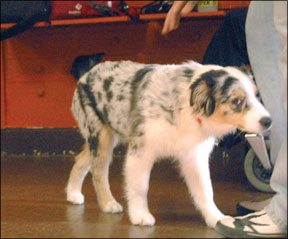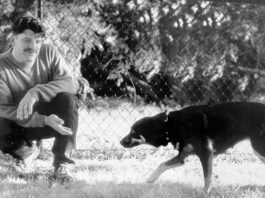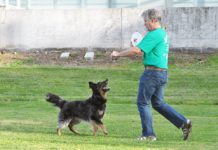How to Safely Break Up a Dog Fight
If you've ever been present when a dogfight broke out, you know how dangerous it can be for everyone concerned. I've lost track of how many times we've said this, but as always, prevention beats cure. It is imperative that you manage and train your own canine family to minimize the risk of serious dogfights. Identify situations that are likely to light the dogfight fuse, such as fence-fighting or resource guarding, and figure out how to avoid them and/or modify the behavior that causes them.
How Dogs Interpret Your Body Language
People who work successfully with dogs either have good instincts about how to interact with them, or they learn quickly. There is a real art to using body language to help a dog feel at ease with your presence. The most competent professionals make training look almost effortless, because all the messages they convey to their canine pupils are calm, clear, and consistent and that means both the cues and rewards they use consciously, and the posture and movements they use without thinking.
Guide to Stress Signals in Dogs
Stress causes the appetite to shut down. A dog who won't eat moderate to high-value treats may just be distracted or simply not hungry, but refusal to eat is a common indicator of stress. Appeasement and deference aren't always an indicator of stress. They are important everyday communication tools for keeping peace in social hierarchies, and are often presented in calm, stress-free interactions. They are offered in a social interaction to promote the tranquility of the group and the safety of the group's members.
5 Things to Know About A Dog’s Threshold
has tuned out his owner
Guide to Reading Canine Body Language
Despite conventional wisdom, a wagging tail doesn't always mean a happy dog. The following abridged Canine/English dictionary will help you become a skilled translator. Remember that breed characteristics can complicate the message; the relaxed ears and tail of an Akita (prick-eared, tail curled over the back) look very different from the relaxed ears and tail of a Golden Retriever (drop-eared; long, low tail). Also note that if body language vacillates back and forth it can indicate ambivalence or conflict, which may precede a choice toward aggression.
Do Dogs Smile?
A well-accepted theory among dog behavior experts is that dogs smile because they know that we humans love it. We see our dogs lounging on the rug with their mouths hanging open, lips pulled back, looking utterly satisfied with themselves, and we go ga-ga with praise and pets. Dogs probably also observe their humans smiling at them and among themselves; they know people smiles are inherently positive (at the very least, benign), and that they can communicate amicability by miming that behavior.
When Your Dog Hates Being Touched
not training. Proceed more slowly
It’s All in Your Dog’s Eyes
Teaching our dogs to look at us is important for training; if we have their attention, we can get them to work with us. If we can keep their attention, we can keep them working with us even in the face of distractions. These things are big accomplishments, but the value of teaching eye contact is even bigger!
Telepathic Communication With Your Dog
Have you ever looked up suddenly and seen your dog staring at you intensely, longingly – a look that grows no less pleading when you offer treats, a walk, or a scratch behind the ears? Or perhaps you’ve seen your dog leap up at some seemingly nonexistent noise, sniffing and whining for no reason you can imagine. Have you wished that you could know what your animal wants, understand what he’s thinking? Or have you ever wondered, when your dog mysteriously disappears at bath time, if he knows what you’re thinking?
Is My Dog Depressed?
When a dog is suddenly no longer interested in their favorite activities, whether it's playing Frisbee in the park or chasing squirrels in the backyard, most animal behavior experts will tell you to look for a physical explanation, not a mental-health recommendation. Taking your four-legged friend to the vet for a physical exam should always be the first response to what seems like depression. A change in behavior can usually be attributed to underlying physical conditions like arthritis or pain.
Analyzing Dog Behavior and Puppy Behavior
Hang with dog folks long enough and you're sure to hear some pretty interesting theories about dog behavior. Some are, of course, useful and accurate, but the dog training world is littered with myths, many of which are at least several generations old. Some of them are just silly; some have the potential for causing serious damage to the dog-human relationship; and still others are downright dangerous. It's time to get past the myths.
Canine Body Language Danger Signs
Dogs almost always give clear signals though the signs may be subtle before they bite. A bite without warning" is truly a rare occurrence. Most of the time the human just wasn't listening

















